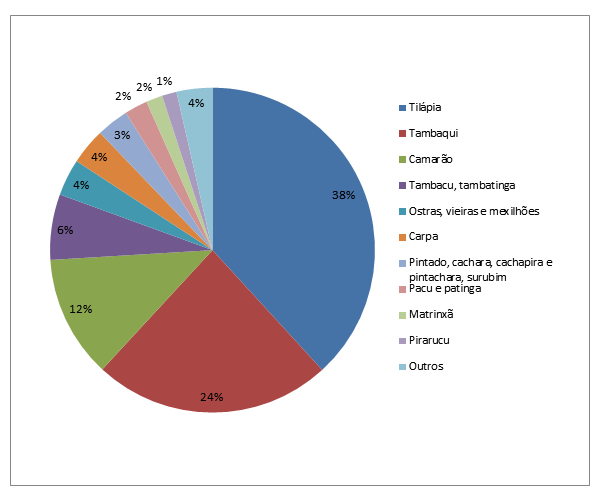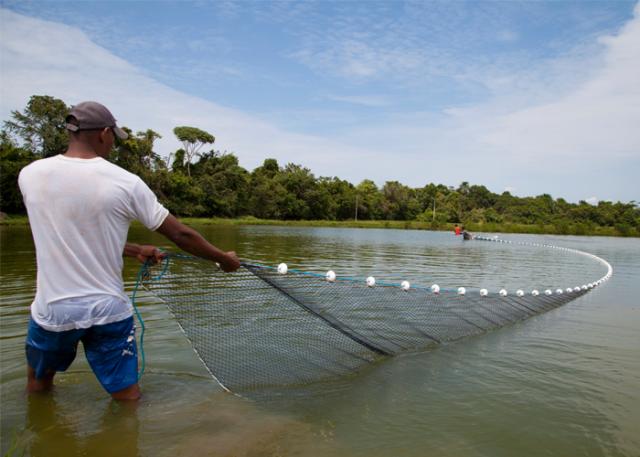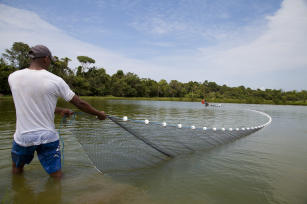Brazilian aquaculture grows 123% in ten years
Brazilian aquaculture grows 123% in ten years
The arrival of new companies, fast professionalization and technological intensification have been some of the factors observed in Brazilian aquaculture, which presented a growth of 123% between 2005 and 2015, a leap from 257,000 to 574,000 tons of fish in the period. These were the findings of a study conducted by the researchers Manoel Pedroza, Andrea Muñoz, Roberto Flores and Eric Routledge, from Embrapa Fisheries and Aquaculture, and presented in this year's conference of the International Institute of Fisheries Economics and Trade (IIFET), in Aberdeen, Scotland.
The work calls attention because the sector dedicated to the production of aquatic animals such as fish and crustaceans used to be characterized in Brazil by small-sized enterprises, extensive production systems and low technological levels, with exception of shrimp production in the Brazilian Northeast.
Pedroza associates such changes with the increase in the demand for fish in the national market, which recorded annual growth rates of over 10% in the same period. However, the study detected that the recent national economic crisis has also had repercussions on the sector's growth in 2015, which grew only 2% in comparison with 2014, from 563,000 to 574,000 tons.
The good performance of the Brazilian aquaculture awakened the interest of important financial institutions such as the Dutch bank Rabobank, the world's largest financer of the agricultural sector. The Dutch institution and the Brazilian Development Bank (BNDES) consider Brazil an important player in world aquaculture, placing it in a position that is similar to countries with tradition in the sector, such as Chile, Vietnam and Norway. Currently, Brazil has recorded the 14th largest aquacultural production of the world, according to the Food and Agriculture Organization of the United Nations (FAO).
Investments in aquaculture
The researchers noted the entrance of larger private enterprises into the Brazilian aquaculture chain. The town of Selvíria, in Mato Grosso do Sul state, received an investment of 160 million reais in a complex that included a tilapia feed, hatchery, fattening and processing plant. Tocantinópolis, TO, saw the construction of a feed plant and fattening fisheries for the tambaqui and spotted sorubim chains, the same species produced in Sorriso, MT, a town where 22 million reais were invested for the setup of cold storage facilities and of a fish feed plant. The town of Almas, in Tocantins, which is a renowned aquacultural center in the state, received facilities for the fattening and processing of tambaqui, spotted sorubim, matrinxã, piau, curimba and pirarucu.
Pedroza also remarked on the recent fusion of two large Brazilian fish processing companies, Geneseas and DellMare. Announced on November 18, the new company is linked to an investment fund focused on agribusiness and will produce 12,000 tons of tilapia and 3,000 tons of vannamei shrimp (Litopenaeus vannamei) per year. "This is another sign of the strength and maturity of the sector in Brazil, which has started to count on major players, following the example of what has already happened with the poulty production chain", the expert compares.
The study also identified the increase in feed prices and the stabilization in fish prices in the country during the period under analysis. "Should the national aquacultural production continue to grow at the rate of 10% a year, one can expect that the tendency of fish prices to stabilize will be maintained, at least in the short and medium run", believes the researcher Manoel Pedroza, for whom the competitive price of the imported product represents strong pressure to keep Brazilian fish at competitive prices.
On top of private investment, the increase in the scale of production is also a result of organization among farmers. The researchers observed the establishment of organizations such as cooperatives, associations, and alternative production models such as fish farming condominiums, which dilute important costs.
According to IBGE's data for the year 2015, freshwater fish production is the main category within Brazilian aquaculture, as it corresponds to 84% of the aquacultural production in the country. Saltwater aquaculture accounts for only 16% of total production, which includes crustacean farming (12%) and the production of oysters, scallops and mussels (4%).
Among fish species, tilapia (Oreochromis niloticus) and tambaqui (Colossoma macropomum) correspond to 62% of the national production, in accordance with the data collected by the Brazilian Institute of Geography and Statistics (IBGE, 2016).

Figure 1 – Brazilian aquacultural production in 2015 per species, in percentages of the total. Source: IBGE/SIDRA.
Technological intensification
The researchers compare the development of aquaculture to the one that occurred to the national poultry production chain, which raised its technological levels and today is one of Brazil's top line of exports. The largest employment of technology, according to the study, took place in the production chain of the most produced fish in Brazil, tilapia, which accounts for 38% of the national production. "Originally from Africa, Nile tilapia is produced in several countries and has a sufficiently advanced technological package", reports the economist Andrea Muñoz, an Embrapa researcher who took part in the study.
A good portion of the information was obtained through panels in the main tilapia producing regions in Brazil: the states of Paraná, Ceará, Bahia, Pernambuco and Minas Gerais. Such activities were held in the scope of the Project "Future Field for Aquaculture", coordinated by Embrapa Fisheries and Aquaculture, which detected the intensification of technologies, including aerators in fisheries that allow for greater fish density; automatic feeder, which reduces labor costs and increases precision in the dosage of feed, and automated harvest.
Another technology the project found was the use of tilapia breeding programs, which provided advances in feed conversion, that is, the ratio of the amount of feed consumed to weight gain. Breeding can also reduce the production cycle and provide animals with higher steak yield.
"Because it is an exotic species that has been produced in several countries for decades, and whose technological package is relatively well developed, tilapia presents better animal performance indicators compared to tambaqui, which still lies at a limited technological level", says the researcher.
The work shows that the biodiversity of the Brazilian aquatic fauna is both a competitive advantage and a bottleneck to development for technological innovation. "This happens because each fish species has different demands, which leads to the prioritization of few species to be developed. Such characteristic is found in major fish producing countries such as Norway, Chile, China, and Vietnam", the researcher Manoel Pedroza clarifies.
Another great challenge for aquacultural research in Brazil is to develop solutions that address the climate diversity in which fish farming is found, considering it is practiced in all Brazilian states.
The study also deems pirarucu (Arapaima gigas) one of the most promising fish species in Brazil.Although it is very appreciated and presents a good yield, the researchers recall that it poses great challenges that compromise the structuring of the pirarucu production chain. Among the most critical obstacles, there is the low training in reproduction in captivity, and the irregular supply of fry (young animals), which makes the price of this input represent almost 25% of the effective operational cost of the activity. In comparison, tambaqui fry represent only 1.6% of such cost.
"When the technological challenges related to reproduction are overcome, there will consequently be greater availability of fry and the cost of this input will fall, improving the economic viability of pirarucu crops", Pedroza believes.
Translation: Mariana de Lima Medeiros
Fabio Reynol (MTb 30.269/SP)
Embrapa's Secretariat of Communications
Embrapa Fisheries and Aquaculture
Press inquiries
imprensa.pesca-e-aquicultura@embrapa.br
Phone number: (63) 3229-7836
Further information on the topic
Citizen Attention Service (SAC)
www.embrapa.br/contact-us/sac/



